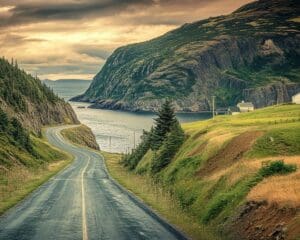Newfoundland and Labrador is one of the most spectacular whale watching places on Earth (See why). Whales aren’t unique to Newfoundland by any stretch of the imagination. Whales are found in every ocean and all over the planet, from the warm waters of the Caribbean to the Arctic Ocean, Antarctica, and even in the deepest parts of the Marianas trench.
Maybe you’ve gone on a whale watching tour in the past, or maybe you’ve had others tell you what to expect, which means you probably have some preconceived ideas about what whale watching will be like in Newfoundland. The thing is, whale watching in Newfoundland is different than anywhere else. It’s much better.
Types
Humpback whales (the ones you see in all the Newfoundland and Labrador tourism campaigns) come to Newfoundland each year to feed on squid, capelin, and krill. That means instead of passing through, they stay here all summer, and instead of being way out in the ocean, they come really close to shore. The largest global population of humpback whales concentrate right here in our coastal waters, which means you can see them feeding, hear them breathing, and even smell their breath from the whale house guest house deck. We don’t just have one or two whales in the bay. We have hundreds, and that’s just counting humpbacks.
You can find another 21 species of dolphins and whales in our coastal waters included sperm whales, blue whales, right whales, pothead whales, minkie,whales, and orcas (lovingly referred to as killer whales).
Whale Hello There
We love whales. That’s part of the reason we live here. There’s something really special about these ocean mammals. If you know a bit about evolution, you’re probably aware life started in the planet’s oceans first before moving to land, but that’s not what happened with whales. Way, way back, the ancestors of whales (mammals like us) lived on the land, and then somehow, they decided to move back into the water.
Some whales live for hundreds of years, much longer than humans, and new research suggests they may be able to communicate with each other over thousands of kilometers (sounds travels through water much better than through air).
Here’s some pictures and a few interesting points about the more popular whales found in Newfoundland waters:
Minke Whale
This whale is found in almost every Newfoundland bay. It’s a baleen whale and is the littlest of all whales. A good way to tell you’re looking at minkie is that they never show their tail above the surface of the water. Like most whales, Minkies love to eat capelin, but they also eat a lot of herring and mackerel. Minkie whales are also great at holding their breath, and can easily stay under water for 20 minutes without needing to come up for air.
Pothead Whale (Also know as the Pilot Whale)
With an ultra-dense rounded head, it’s easy to see where these whales got their name. These whales have sharp teeth and travel in large packs (pods is the correct term when talking about whales) with up to 150 whales in each pod. Their favorite food is squid. We like squid too.
Fin Whale
The fin whale is an enormous baleen whale. It’s actually the second largest species of whale in the world (if that statement instantly made you wonder which one is the largest, keep reading). Fin whales go further and explore more than most other whales and travel in groups of 10 or less.
Blue Whale
Did you ever wonder what’s the largest mammal that’s ever lived on our planet? It’s the blue whale. Up to 30 meters long (that’s 90 feet) this super massive baleen whale is a regular winter visitor to the south coast of Newfoundlad where they feast of krill. How much krill does it take to fill a blue whale’s belly? Approx 2200 lbs. That’s a lot of krill.
Harbour Porpoise
This tiny whale likes to travel in groups five or less, has a dark colored back and a bright white belly. They’re easily identified by the loud grunting sound they make when taking a breath.
Dolphins (yes dolphins are whales)
Both white sided and white beaked dolphins can be found all over Newfoundland. Call me captain obvious, but you can tell them apart easily because one has a white nose and the other doesn’t (we’ll let you figure out which is which). Dolphins are social, curious, and generally friendly, just like most people in Newfoundland.
Orca (Killer Whale)
If you’ve ever seen a marine land commercial or watched someone training a whale in captivity (whales should never be held in captivity) you know what on orca whale looks like. These whales are kind of like wolves of the sea. They hunt in packs, eat everything from seals to other whales, and have a big set of scary teeth. They’re known for targeting humpback babies (a baby whale is called a cow) by separating them from their mother and drowning them underwater. Killer whales are master hunters.
Sperm
Sperm whales are really something. They’re the biggest toothed whale on the planet, have a unique light gray color, and a blowhole that sits on the side of the whales head. Sperm whales are master divers, and can dive deeper than any other whale species, often times hunting for elusive giant squid in the deepest parts of the ocean.
Humpback
Looking for Humpback whales? You’ve come to the right place. Newfoundland has the worlds largest concentration of humpback whales. It’s easier to see a humpback whale here in Newfoundland than anywhere else on the planet because their population is concentrated in our coastal waters all summer long and they feed relatively close to shore.
Humpbacks are also famous for putting on a show, sometimes jumping straight out of the water.
Come see for yourself, book your stay today!




